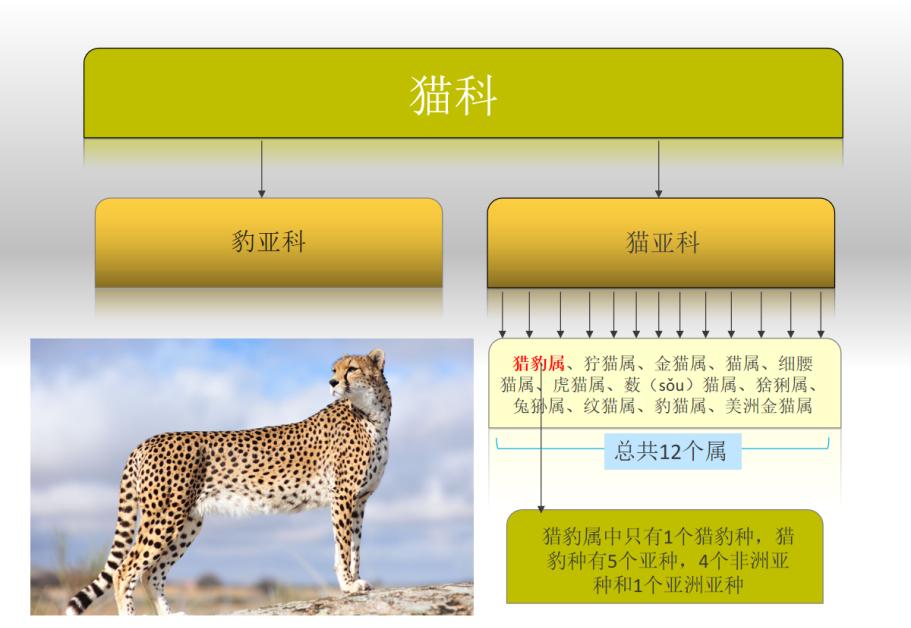Cheetah is a feline, a species in the genus Cheetah in the genus Cats, the cat family, which has 5 subspecies, 4 African subspecies and 1 Asian subspecies, divided mainly by geographical location, and their difference lies in the slight change in fur color.

What are the characteristics of cheetahs?
Cheetah cubs have a smoky grey coat color, yellow or brown adults, short and rough coats, solid round or oval black spots on the body, while the neck and abdomen are white and have no spots. The tail has four to six black rings at the end, and the tip of the tail is a clump of white fluff.
Cubs
The cheetah's slender body and limbs, small head, and higher eye position distinguish it from other spotted cats are distinguished by two black tear marks on the face that extend from the inner corner of each eye to the mouth. The cheetah's paws are semi-telescopic and can hold the ground steadily when running at high speeds, providing power for fast forward, and such claws are somewhat like dogs rather than cats. There are three other species of cats whose paws are also semi-retractable: fishing cats, flat-headed cats, and nishimethae cats, all of which are species in the genus Ocelot.
Characteristic tear marks
Semi-retractable claws
Adult cheetahs are 70–90 cm tall on the shoulders, 1–1.5 m in body length, weigh 20–65 kg and have a tail length of 65–85 cm. Males are slightly larger than females.
Cheetahs are the fastest animals on land: they can reach a top speed of 110-120 km/h. In high-speed running, they advance at a distance of about 7 meters per step and can accelerate from 0 to top speed in 3 seconds.
Cheetahs cannot roar as loud as lions and tigers, but make low inhaling sounds, birds and cat-like meows.
Video loading...
The video contrasts the roar of the lion and tiger with the various sounds made by the cheetah
Where do cheetahs live?
Cheetahs are found in parts of sub-Saharan Africa, as well as in Iran in Asia. They prefer dry and open areas, such as deserts, various types of grasslands, and light woodlands, and basically do not enter dense forests.
What do cheetahs eat?
Cheetahs are most active during the day, hunting mainly in the early morning and late afternoon. This avoids competition with other predators, such as lions and hyenas, which hunt at night.
Cheetah hunting relies more on sight than smell, usually scanning the surroundings on a hillock, locking on to the target, slowly tracking and moving within 100 meters of the target, and then sprinting to pursue. When chasing close enough to the prey, it will jump on the prey and trip it, then bite the prey's neck and suffocate it.
Observe first
Cheetahs prefer to prey on medium-sized, under 40Kg prey, and their main diets include springbok, stone antelope, impala and gazelle, and occasionally have the opportunity to prey on larger animals, including warthogs, kudu (an African antelope), antelope, variegated horses and sables. They also eat birds and rabbits.
Cheetahs have a success rate of about 50% in hunting prey. Because although the cheetah runs fast, it cannot last, and it consumes a lot of energy to run at high speed, so it can only last about 300 meters. Moreover, their heads are small, their nose passages are large, and there is no room for teeth to deeply root, so the cheetahs' small teeth and the lack of physical strength make their combat effectiveness very limited.
Cheetahs have teeth that are not as long as lions
Cheetahs from birth to the end of life
Cheetahs are sexually mature at about 18 to 23 months. The gestation period is about 3 months, and the average number of litters is 2-5. Although there is no definite breeding season, most of them are in the rainy season, because this time is the season when the gazelle is born, and there is a lot of food and good hunting.
The pups are born with a smoky grey fur and a long mane on the back that provides cover for the cubs from the top of the head to the base of the tail.
The cubs are born with their eyes closed and cannot be opened until about two weeks, which is very fragile. At about six weeks, they hunt with their mothers, and at six months of age, they catch live prey and let them practice hunting.
At 18 months old, the baby cheetahs would leave their mothers to live alone. After leaving their mothers, the baby cheetahs form a group of siblings and live together for 6 months. Around the age of two, the female sisters left the group to live independently. The remaining male fraternities form male alliances, which sometimes include foreign male members. But not all males form alliances, and some live alone. In the Serengeti steppes, the study found that about 41 percent of adult males lived alone, 40 percent were two-pack alliances, and 19 percent were three-pack alliances.
Male Alliance
The average lifespan of a wild cheetah is 10-12 years. In captivity, lifespan can reach 17-20 years.
Threats to cheetahs
Natural enemy persecution: Lions, hyenas, eagles these predators prey on and persecute cheetah cubs, cheetah cubs survive very difficult, the mortality rate of more than 50%.
At the same time, due to the loss of habitat, the decline of prey and the continuous conflict with humans, the number of cheetahs is decreasing, and the International Union for Conservation of Nature lists it as an endangered species. The 2016 data shows that the number of wild cheetahs in the world is about 7100, and the number of wild cheetahs in Iran has dropped from 60-100 in 2007 to about 43 in 2016.